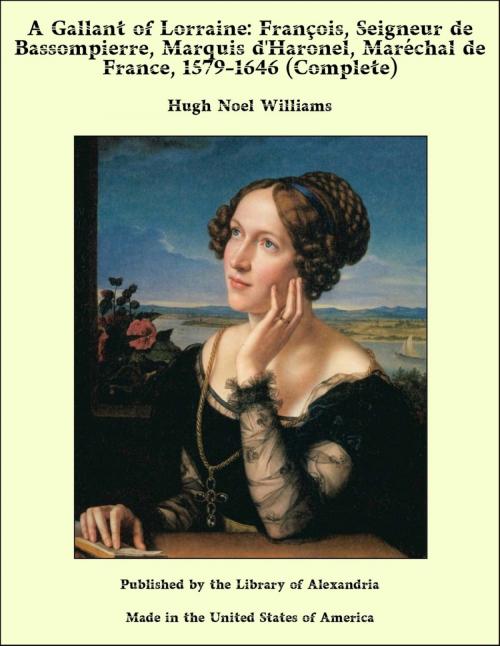A Gallant of Lorraine: François, Seigneur de Bassompierre, Marquis d'Haronel, Maréchal de France, 1579-1646 (Complete)
Nonfiction, Religion & Spirituality, New Age, History, Fiction & Literature| Author: | Hugh Noel Williams | ISBN: | 9781465610317 |
| Publisher: | Library of Alexandria | Publication: | March 8, 2015 |
| Imprint: | Language: | English |
| Author: | Hugh Noel Williams |
| ISBN: | 9781465610317 |
| Publisher: | Library of Alexandria |
| Publication: | March 8, 2015 |
| Imprint: | |
| Language: | English |
François de Bassompierre was born at the Château of Harouel, in Lorraine, on Palm Sunday, April 12, 1579, “at four o’clock in the morning.” His family, which was one of the most ancient and illustrious of Lorraine, appears to have owed its name to the village of Betstein, or Bassompierre, near Sancy, which formed part of its possessions until 1793, when it was confiscated and sold by the Government of Revolutionary France, with the rest of the Bassompierre property. If we are to believe the very confusing documents which François de Bassompierre collected about his family, it descended from the German House of Ravensberg, but, according to the learned genealogist, Père Anselme, its origin can be traced to the latter part of the thirteenth century, to one Olry de Dompierre, who became possessed of the fief of Bassompierre by marriage, and whose son, Simon, adopted the name, which became that of his descendants. However that may be, it was undoubtedly a very old family indeed, as well as a distinguished one, and, like most old families, had its mysterious traditions; but, at any rate, the legend of the Bassompierres had nothing sinister about it. The story goes that during the transitory reign of that Adolph of Nassau who lost his Imperial crown and his life at the Battle of Spire, there lived a certain Comte d’Angerveiller, or d’Orgeveiller. This nobleman, as he was returning home one evening from hunting—it was a Monday—stopped to rest at a summer-house situated in a wood a little distance from his château. There, to his astonishment, he found a young and beautiful woman—a fairy, it is said—(She must surely have been the last of the race!)—apparently awaiting his arrival. And the pair were so well pleased with one another at this first interview, that for two whole years they failed not to meet every Monday at the same rendezvous, “the count pretending to his wife that he had gone to shoot in the wood.” However, as time went on, the countess began to conceive suspicions, “and one morning entered the summer-house, where she found her husband with a woman of perfect beauty, and both asleep. And being unwilling to awaken them, she merely spread over their feet a kerchief which she was wearing on her head, which, being perceived by the fairy, she uttered a piercing cry and began to lament, saying that she must see her lover no more, nor even be within a hundred leagues of him; and so left him, having first bestowed upon him these three gifts—a spoon, a goblet and a ring, for his three daughters, which, said she, they must carefully preserve, as, if they did this, they would bring good fortune to their families and descendants.” Well, a lord of Bassompierre, an ancestor of the marshal, married one of the three daughters of the Comte Orgeveiller, who brought him as her dowry, together with certain fat lands, the spoon; and, in memory of this tradition, the town of Épinal, of which he had been burgrave, was obliged to offer to him and his descendants, on a certain day each year, by way of quit-rent, a spoonful from every measure of corn sold within its walls.
François de Bassompierre was born at the Château of Harouel, in Lorraine, on Palm Sunday, April 12, 1579, “at four o’clock in the morning.” His family, which was one of the most ancient and illustrious of Lorraine, appears to have owed its name to the village of Betstein, or Bassompierre, near Sancy, which formed part of its possessions until 1793, when it was confiscated and sold by the Government of Revolutionary France, with the rest of the Bassompierre property. If we are to believe the very confusing documents which François de Bassompierre collected about his family, it descended from the German House of Ravensberg, but, according to the learned genealogist, Père Anselme, its origin can be traced to the latter part of the thirteenth century, to one Olry de Dompierre, who became possessed of the fief of Bassompierre by marriage, and whose son, Simon, adopted the name, which became that of his descendants. However that may be, it was undoubtedly a very old family indeed, as well as a distinguished one, and, like most old families, had its mysterious traditions; but, at any rate, the legend of the Bassompierres had nothing sinister about it. The story goes that during the transitory reign of that Adolph of Nassau who lost his Imperial crown and his life at the Battle of Spire, there lived a certain Comte d’Angerveiller, or d’Orgeveiller. This nobleman, as he was returning home one evening from hunting—it was a Monday—stopped to rest at a summer-house situated in a wood a little distance from his château. There, to his astonishment, he found a young and beautiful woman—a fairy, it is said—(She must surely have been the last of the race!)—apparently awaiting his arrival. And the pair were so well pleased with one another at this first interview, that for two whole years they failed not to meet every Monday at the same rendezvous, “the count pretending to his wife that he had gone to shoot in the wood.” However, as time went on, the countess began to conceive suspicions, “and one morning entered the summer-house, where she found her husband with a woman of perfect beauty, and both asleep. And being unwilling to awaken them, she merely spread over their feet a kerchief which she was wearing on her head, which, being perceived by the fairy, she uttered a piercing cry and began to lament, saying that she must see her lover no more, nor even be within a hundred leagues of him; and so left him, having first bestowed upon him these three gifts—a spoon, a goblet and a ring, for his three daughters, which, said she, they must carefully preserve, as, if they did this, they would bring good fortune to their families and descendants.” Well, a lord of Bassompierre, an ancestor of the marshal, married one of the three daughters of the Comte Orgeveiller, who brought him as her dowry, together with certain fat lands, the spoon; and, in memory of this tradition, the town of Épinal, of which he had been burgrave, was obliged to offer to him and his descendants, on a certain day each year, by way of quit-rent, a spoonful from every measure of corn sold within its walls.















